The bicep curl is a fundamental exercise that can help you build a stronger and bigger bicep. But did you know there are several ways to perform this classic exercise?
Adding bicep curl variations to your workout routine will allow you to effectively target your biceps from multiple angles and break through plateaus.
You will challenge your biceps in new and dynamic ways with the dumbbell hammer curl, barbell preacher curl, concentration curl, incline curl, and cable curl.
Each variation has unique advantages, from increased stability and muscle engagement to enhanced muscle contraction and isolation.
In this blog, we’ll explore the following topic:
- Different ways to do bicep curls
- How To Do and Pro Tips
- Specific benefits of each variation.
- Sample bicep curl workout plan
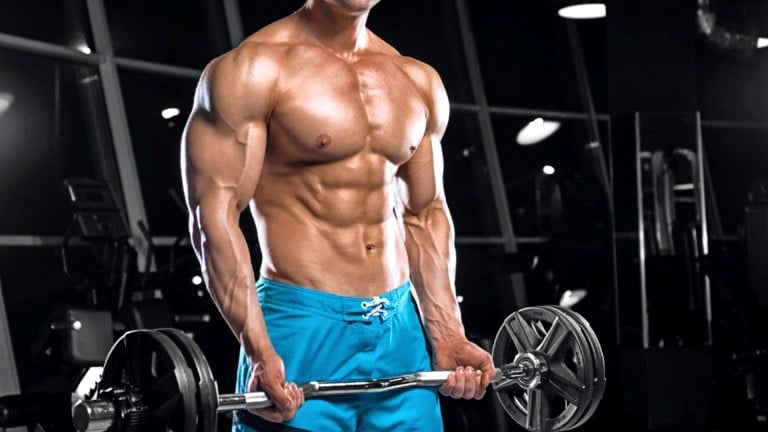
- Biceps Brachii Muscle (Anatomy)
- 12 Best Bicep Curl Variations
- 1. Standard Bicep Curl
- 2. Hammer Curl
- 3. Reverse Curl
- 4. Zottman Curl
- 5. One Arm High Cable Curl
- 6. Spider Curl
- 7. Incline Dumbbell Curl
- 8. Preacher Curl
- 9. Behind The Back Cable Curl
- 10. Lying Cable Curl
- 11. Drag Curl
- 12. Standing Preacher Curl
- Bicep Curls Workout Routine
- Reps, Sets, And Frequency For Bicep Curls
- Beginner Bicep Curls Workout Routine
- Intermediate Bicep Curl Workout Routine
- FAQs
- What is the easiest bicep curl variation?
- What is the hardiest bicep curl variation?
- How many variations of biceps are there?
- Conclusion
- Video illustration of Bicep Curl Variations
Biceps Brachii Muscle (Anatomy)
The biceps brachii muscle (biceps) is a large, thick upper arm muscle. It is attached to the forearm bone called the radius and originates at the scapula in two heads (the bicep gets its name from the two heads).
Your biceps brachii has two heads: short (inner) and long (outer).
- The short head is located along the inner side of the anterior upper arm, and the long head is along the outer side.
- The long head comprises most of the biceps’ peak, whereas the short head sits on the inner side and contributes to the width of the biceps.
The biceps is one of four muscles, along with the brachialis, brachioradialis, and coracobrachialis, that comprise the upper arm.

12 Best Bicep Curl Variations
It’s important to know how to do each variation correctly to get well-sculpted arms and take your bicep workouts to the next level.
Let’s learn different ways to do bicep curls and strengthen and define our arms.
- Standard Bicep Curl
- Hammer Curl
- Reverse Curl
- Zottman Curl
- One Arm High Cable Curl
- Spider Curl
- Incline Dumbbell Curl
- Preacher Curl
- Behind The Back Cable Curl
- Lying Cable Curl
- Drag Curl
- Standing Preacher Curl
1. Standard Bicep Curl
Standard bicep curls are a good starting point if you want to add a simple bicep exercise to your routine.
The standard bicep curl is a well-known exercise for building bicep muscle mass. It’s a great exercise for seeing results in strength and definition.
There are different ways to do a standard bicep curl to build bigger and stronger biceps.
- Dumbbell Bicep Curl
- Cable Curl
- Wide Grip Barbell Curl
- Close Grip Barbell Curl
- Ez Bar Curl
A barbell curl is a pull-type, isolation exercise that works primarily on your biceps and also trains the muscles in your forearms.
Note: In the study conducted, they found that the EZ barbell curl showed the highest overall electromyography (EMG) activity in the biceps brachii (BB) and brachioradialis (BR) muscles compared to the dumbbell curl (DC) and barbell curl (BC) variants.
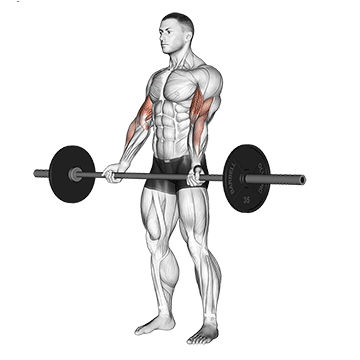
How To Do Barbell Curl
- Stand straight up with your feet shoulder-width apart.
- Hold a barbell with an underhand grip (palms facing up) and your hands slightly wider than shoulder-width apart.
- Allow the barbell to hang in front of your thighs at arm’s length.
- Keep your upper arms close to your sides and your elbows stationary.
- Start the exercise by bending your elbows and pulling the barbell towards your chest.
- Continue curling until the barbell is at shoulder level.
- Hold this position briefly and squeeze your biceps to maximize the contraction.
- Slowly lower the barbell back to the starting position.
Know More: Barbell Bicep Exercises & Workout For Mass & Strength
2. Hammer Curl
When it comes to building massive biceps and forearms, the dumbbell hammer curl is an effective isolation workout that targets the bicep, brachialis and brachioradialis.
It is performed by holding dumbbells with a neutral grip (palms facing inward) instead of the traditional supinated grip (palms facing upward).
The hammer curl is one of the most popular exercises among bodybuilders and regular weightlifters.

How To Do Hammer Curl
- Stand with your feet shoulder-width apart and a slight bend in your knees.
- Hold dumbbells in your hands with your palms facing towards your body.
- Slowly curl up the dumbbell up to your shoulders while keeping your elbows close to your body.
- Pause at the top of the lift for a second, squeeze your biceps, and then lower the weights under control.
- Neither lean back as you lift the weight nor lean forward as you lower it.
3. Reverse Curl
The reverse curl is a variation of the bicep curl exercise that targets the muscles from a different angle. Unlike the traditional bicep curl, the barbell reverse curl is performed with an overhand grip (palms facing down) on the barbell.
A pronounced grip will engage the brachioradialis and other forearm muscles to a greater extent. This also helps to improve grip strength and forearm and bicep development.
Other ways to do the Reverse Curl:
- Cable Reverse Curl
- Dumbbell Reverse Curl
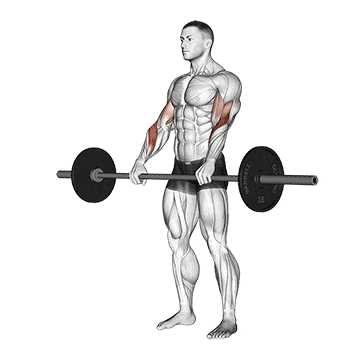
How To Do Barbell Reverse Curl
- Stand up straight with your feet shoulder-width apart.
- Grasp the barbell with an overhand grip, slightly wider than shoulder-width apart.
- Your palms should be facing down, and your hands should be positioned just outside of your thighs.
- Exhale and slowly curl the barbell upwards toward your shoulders.
- At the top of the curl, feel the contraction in your biceps and forearms.
- Inhale and slowly lower the barbell back down to the starting position.
4. Zottman Curl
The Zottman Curl is a creative and effective variation of the standard bicep curl. It targets your biceps and forearms at the same time.
The exercise primarily targets the biceps during the concentric (lifting) phase when your palms face upward. However, during the eccentric (lowering) phase, you rotate your wrists so that your palms face downward, engaging the forearms and providing an effective forearm workout.
The Zottman curl can be done with both arms at once, or with alternate arms.
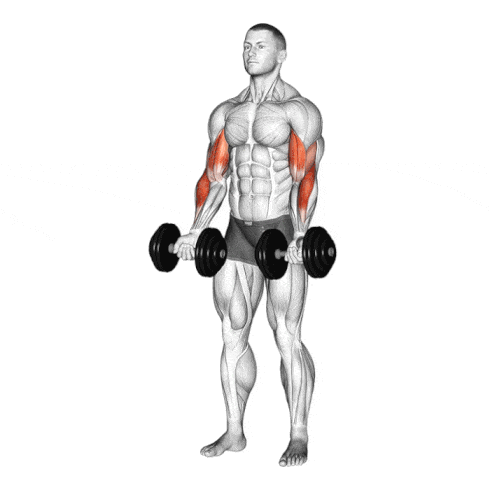
How To Do Zottman Curl
- Stand up straight with your feet shoulder-width apart.
- Hold a dumbbell in each hand with an underhand grip (palms facing upward).
- Lift the weights up towards your shoulders while keeping your upper arms still.
- When the weights are close to your shoulders, turn your wrists so your palms face down.
- Slowly lower the dumbbells back down to the starting position.
- At the bottom of the movement, rotate your wrists to return to the starting position with palms facing upward (supination movement).
- For the best results, perform this exercise in a slow, controlled manner.
Know More: Best Brachioradialis Exercises For Bigger Forearms
5. One Arm High Cable Curl
The high cable curl exercise is a good way to work on your biceps and make them bigger and thicker. There are two main versions of the high cable curl:
- One-arm high cable curl
- Two-arm high cable curl
Both variations are effective, but the one-arm version allows you to use more relative weight for potentially greater gains in biceps size and strength.
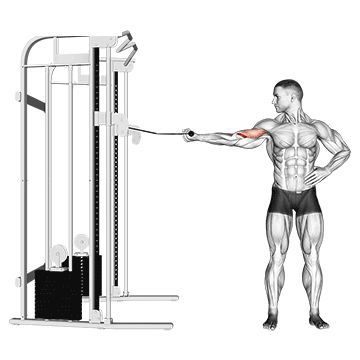
How To Do
- Stand sideways next to a high pulley machine, with your arm extended out to about shoulder height.
- Grip the handle with one of your hands.
- Slowly curl the cable towards your head, isolating the bicep until you feel tension.
- Hold for a count of two and squeeze your biceps brachii.
- Return to the starting position and repeat for as many reps and sets as desired.
- Repeat the exercise with your opposite arm.
6. Spider Curl
Spider curls are a remarkable exercise for building the biceps because they produce an intense muscle contraction on every single rep.
That why it is one of the best bicep exercises you can consider incorporating into your training regime if you want a bulging short head bicep.
This is a good exercise to change things up and keep your biceps working hard, especially the short head, which must do most of the work.
It is possible to do spider curls in many ways.
- Barbell Spider Curls
- EZ Bar Spider Curls
- One-Arm Spider Curl
- Flat Bench Spider Curl
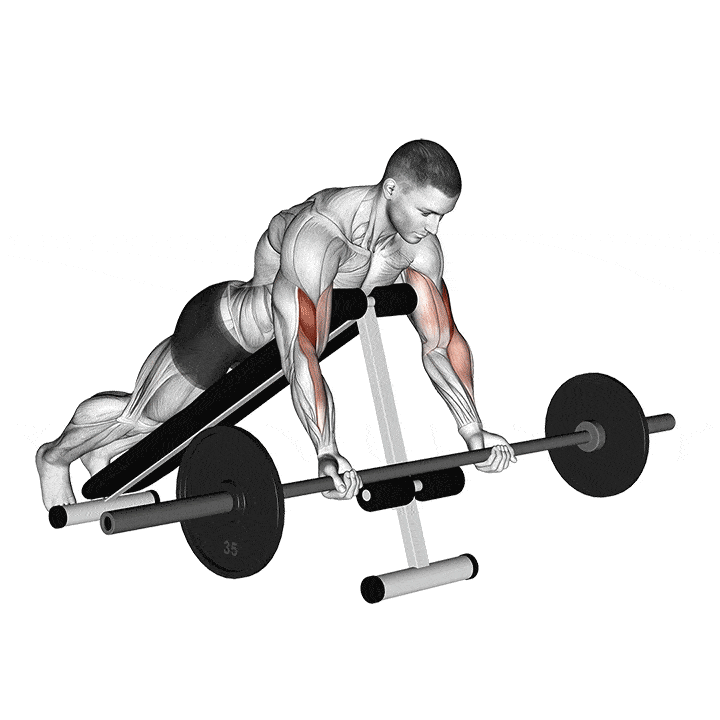
How To Do Barbell Spider Curl
- Adjust the bench to an incline, and level to a 60-degree angle.
- Grab the barbell with an underhand grip.
- Lie on the bench in a reverse position with your chest pressed into the backrest.
- Let your arms hang in front of your torso.
- Curl the weight toward your shoulders and squeeze your biceps.
- Hold the contraction for a moment.
- Then lower the weights under control until your elbows are fully extended.
7. Incline Dumbbell Curl
The incline dumbbell curl is a variation of the bicep curl performed on an inclined bench. One of the primary benefits of the incline dumbbell curl is the increased stretch and range of motion it provides to the long head of your bicep.
When you perform the curl on an incline bench, the arms start in a more extended position, which allows for a deeper stretch at the bottom of the movement.
There are different ways to incline a dumbbell curl.
- Incline Hammer Curl
- Incline Alternating Curl
- Incline Zottman Curl
- Incline Reverse Curl
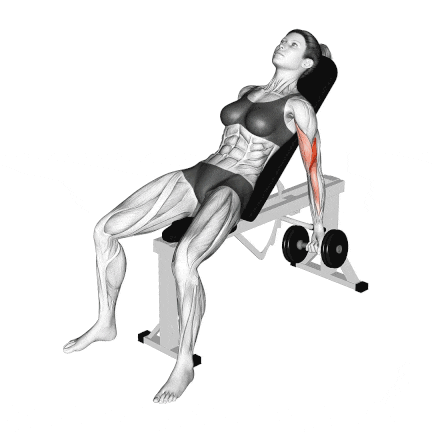
How To Do Incline Dumbbell Curl
- Set an adjustable bench to a 45-degree incline and sit on it with a dumbbell in each hand.
- Hold a pair of dumbbells at arm’s length with your palms facing forward.
- Keep your elbows close to your body and your upper arms stationary.
- Slowly curl the dumbbells towards your shoulders.
- At the top of the movement, your biceps should be fully contracted.
- Slowly lower the dumbbells back to the starting position.
8. Preacher Curl
The preacher curl isolates the biceps muscles by eliminating momentum and limiting the involvement of other muscles. This allows for a more targeted and intense bicep workout.
With a preacher curl, you get a lot of benefits that don’t come with regular bicep curls. Do preacher curl with a little wider grip to impart more load on short head biceps.
There are many ways to do preacher curls, and each one has its benefits.
- Dumbbell Preacher Curls
- Reverse Grip Preacher Curls
- Preacher Curl Machine
- Cable Preacher Curls
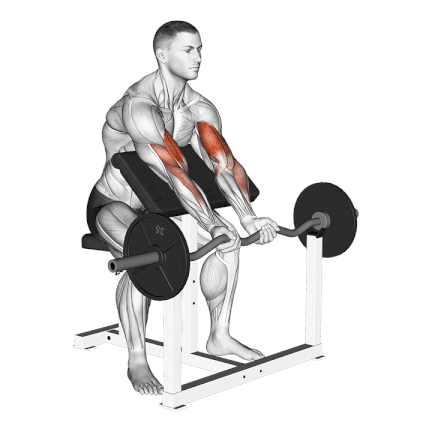
How To Do Preacher Curl
- Get seated on the Preacher Bench with your chest against the support.
- Grab the bar placed on the preacher’s bench rack in front of you.
- Curl the bar as in a standard barbell curl and get maximum contraction at the top.
- Lowering the bar slowly gives constant stress throughout the movement.
- Lowers the bar to get the maximum extension.
- During the last few reps, your short biceps heads should feel burning and intense.
- Use a wide grip to work the short-head biceps and a close grip to work the outer biceps.
9. Behind The Back Cable Curl
Unlike traditional bicep curls, this variation involves curling the cable attachment from a position behind your body, resulting in a different angle of resistance and muscle activation.
The behind-the-back cable curl is similar to the incline dumbbell curl. Your arms will be curling with your elbows behind you, which emphasizes the long head.
It provides constant tension to the biceps throughout the entire range of motion.
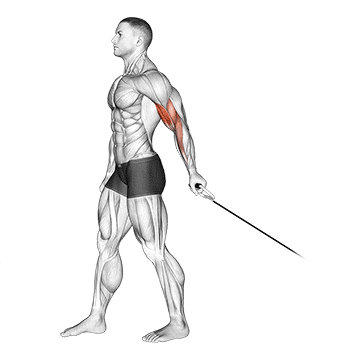
How To Do Behind The Back Cable Curl
- Attach a single cable handle to the bottom of a cable pulley.
- Grab the handle with an underhand grip and then face away from the machine.
- Take a step out from the cable station and let your arm travel behind your torso until you feel a good stretch in your biceps.
- Exhale and curl the bar upward towards your shoulders, contracting your biceps.
- Lower the weight back down under control until your elbow is fully extended.
- Repeat for the ideal number of reps to complete the set.
- Now, switch arms to complete the exercise on your right side, and then alternate between arms for sets.
Know More: Bicep Cable Workout To Build Mass And Strength
10. Lying Cable Curl
If you’re looking for a way to get more creative with your biceps curl variations, why not try lying (supine) cable curls?
The point of lying on your back for the lying cable curl is to eliminate all body momentum and, therefore, prevent cheating and better isolate your elbow flexors.
It is performed on the back, either on a bench or the ground, with the feet facing toward a cable stack. This movement is usually performed for moderate to high reps for a burn and pump as part of an arm-focused workout.
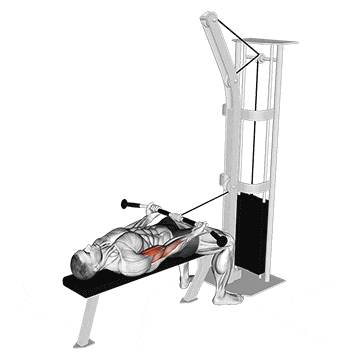
How To Do Lying Cable Curl
- With both hands, grasp a straight bar or bar attachment that is attached to the pulley, using an underhand (palms facing up) grip.
- Lie down on the bench in front of the weight stack with your feet flat against the frame of the pulley machine
- While keeping your upper arms stationary and the elbows close to your body, curl the bar up to your chest.
- Slowly return to the start position.
- Do not allow your body to come off of the floor or bench.
- Keep the rep timing slow and control the weight as you lower it.
11. Drag Curl
While less popular than the standard dumbbell bicep curl, the dumbbell drag curl is an extremely effective bicep exercise.
When curling, the dragging motion of the dumbbells allows for a greater range of motion, leading to a more intense contraction of the biceps.
It is a unique bicep curl variation in which you don’t completely bring the weight in front of your body. This makes it more difficult to swing and use momentum to lift the weight.
There are other ways to do drag curls to build a bigger bicep.
- Cable Drag Curl
- Barbell Drag Curl
- Ez Bar Drag Cur
- Kettlebell Drag Curl
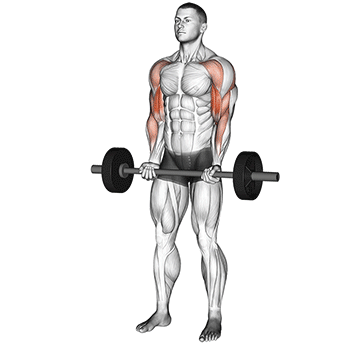
How To Do Barbell Drag Curl
- Keep your feet shoulder-width apart and your knees slightly bent for stability.
- Grab the barbell with an underhand (supinated) grip.
- Bring your elbows and shoulders back slightly as you curl the weight upwards.
- It should feel like you are “dragging” the barbell up to your body.
- Squeeze your biceps hard at the top and slowly return to the starting position.
- Start with lighter weights to get used to the movement and form.
12. Standing Preacher Curl
Finally, if you’re looking for a more effective way to do bicep curls, try standing preacher curl. This exercise targets the biceps, emphasizing isolation, stability, and control.
The preacher bench prevents excessive swinging or cheating, ensuring proper bicep isolation and minimizing the involvement of other muscles. This leads to a more intense contraction in the biceps, allowing for focused muscle development.
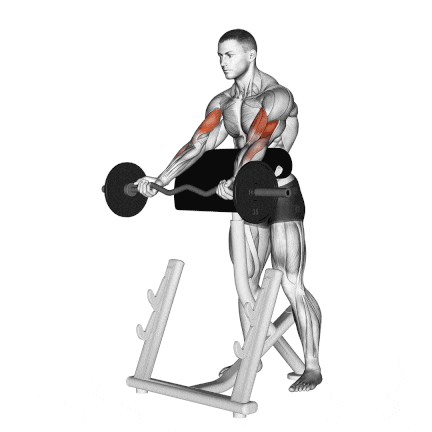
How To Do Standing Preacher Curl
- Standing with a staggered stance close to the preacher’s curl bench.
- Place the back of your upper arms on the preacher bench pad, and then grab the EZ Bar.
- Curl the EZ bar until it reaches your shoulder level and gets maximum contraction at the top.
- Hold the position for 1–3 seconds and lower the bar so your arms are again fully extended.
- Repeats the desired number of sets.
- Keep the motion slow and controlled throughout the set.
Bicep Curls Workout Routine
Follow our expert-designed bicep curls workout routine for arm-blasting results to target your biceps from various angles, keep them guessing, and promote maximum growth.
Reps, Sets, And Frequency For Bicep Curls
The bicep curl exercises listed will be performed with moderate loads and repetitions to emphasize both muscular hypertrophy (muscle growth) and muscular endurance. Load and volume (sets, reps) can be increased as your fitness and strength improve.
- For muscle hypertrophy (muscle growth): Aim for a rep range of 8-12 reps per set
- For strength and power: Lower the rep range to around 4-6 reps per set.
- For Endurance: Do 15-20 reps per set.
However, here are some general guidelines to help you get started:
| Level | Reps | Sets | Weekly Sets | Frequency |
|---|---|---|---|---|
| Beginners | Start with 8-10 repetitions | 2-3 | ~10 | 1-2 times per week |
| Intermediate | Aim for 10-12 repetitions | 3-4 | ~15 | 2-3 times per week |
| Advanced | Increase the challenge by performing 8-12 reps | 4-5 | ~20 | 2-3 times per week |
Beginner Bicep Curls Workout Routine
| Exercise | Sets | Reps | Rest between Sets |
|---|---|---|---|
| Barbell Bicep Curls | 3-4 | 8-10 | 60-90 sec |
| Dumbbell Hammer Curls | 3 | 10-12 | 60-90 sec |
| Cable Reverse Curls | 3 | 8-10 | 60-90 sec |
Intermediate Bicep Curl Workout Routine
| Exercise | Sets | Reps | Rest between Sets |
|---|---|---|---|
| Barbell Bicep Curls | 4 | 8-10 | 60 sec |
| Preacher Curls | 4 | 8-10 | 60-90 sec |
| Cable Hammer Curls | 3-4 | 10-12 | 60 sec |
| Concentration Curls | 3-4 | 8-12 | 60 sec |
FAQs
What is the easiest bicep curl variation?
The standing dumbbell curl and hammer are the easiest bicep curl variations.
What is the hardiest bicep curl variation?
Incline curl and Spider bicep curl are the hardest types of bicep curls to do.
How many variations of biceps are there?
There are numerous variations of bicep exercises that target and engage the biceps muscles in different ways. Some common variations include
- Standard bicep curls
- Hammer curls
- Concentration curls
- Preacher curls
- Cable curls
- Incline curls
- Reverse curls
- Zottman curl
- Spider curls.
Conclusion
Mastering the bicep curl and its variations is essential for sculpting strong and defined arm.
You can get a more well-rounded and sculpted arm by adding hammer curl, concentration curl, preacher curl, incline curl, and reverse curl to your arm workout routine.
Always focus on proper form and technique when doing bicep curls. Also, try different weights and reps, take breaks to recover, and avoid common mistakes to get the most out of your bicep curl workouts.
Get ready to build a strong and defined bicep like never before.
Video illustration of Bicep Curl Variations

Manish is a NASM-certified fitness and nutrition coach with over 10 years of experience in weight lifting and fat loss fitness coaching. He specializes in gym-based training and has a lot of knowledge about exercise, lifting technique, biomechanics, and more.
Through “Fit Life Regime,” he generously shares the insights he’s gained over a decade in the field. His goal is to equip others with the knowledge to start their own fitness journey.

